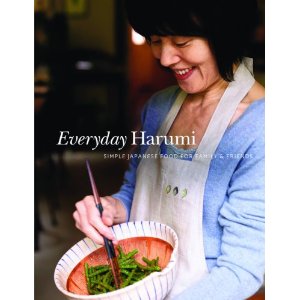Books |
Everyday Harumi
Harumi Kurihara
By
Published: Jun 08, 2010
Category:
Food and Wine
Harumi Kurihara is almost unknown in America, but in Japan, she’s a household name — literally. Like: 52 shops in department stores. Like: 12 cafes and restaurants. Like: books and books.< Just don’t think of her as “the Martha Stewart of Japan Martha is an entrepreneur but I am a housewife, and I want to continue,” she says. She started giving cooking classes because her husband and child loved the way she cooked, and even when she became a successful teacher, she still took her greatest pleasure from making family dinners. One thing led to another, and she began sending articles to magazines. In 1992, she published her first cookbook, "Gochisosama Ga Kikitakute!," which means "I want to hear you say delicious!" Her publisher hated the title. 'It is too casual and inappropriate. It sounds like the title of an essay, not a book' was the complaint," Harumi has said. "But I did not compromise. The book sold over a million copies and remains in print. I feel vindicated." Everyday Harumi, her most recent book, was created for Western home cooks. It capitalizes on our attraction for Japanese food — its lightness, its scant use of meat, fat and dairy products, its smaller portions, its creative use of vegetables. Even better, it’s not for purists. This is a cookbook for housewives, both literal and metaphorical. That is, it’s for busy people who have little time to cook but who are too proud, cost-conscious and health-minded to order take-out.
It is, simply, the most useful and creative approach to Japanese cooking I have yet encountered. Harumi is to Japan what Marcella Hazan is to Italy and Patricia Wells is to France. Though new in our home, Harumi’s book is already food-stained — the ultimate compliment.
What you get are more than 70 user-friendly recipes, most of them simple to prepare. Yes, you have to do some shopping first, but you’ll be buying oils, spices and condiments that will find their way into many dishes. And the recipes are, mostly, simple in the extreme. Barbecue sauce: 12 ingredients, a few minutes of preparation, brief cooking, and you’re done.
Western influences? Chicken and celery salad, with mayonnaise in the dressing. Japanese hamburger (tsukune). Ginger pork with bok choy: 6 ingredients, 6 steps. Green beans with ground pork. Lots of fish. Mashed potatoes with a Japanese-style mushroom sauce. Japanese coleslaw. Sauteed leeks and mushrooms.
Simple family meals? Rice with soy-flavored pork and carrots. Fried rice with crabmeat. Stir-fried noodles with pork and cabbage. A surprising tofu “steak.” Several varieties of miso soup.
Vegetables? You expect green beans with sesame dressing, but pumpkin with a sweet sesame glaze (4 ingredients, 4 steps) will surprise you. Ditto potatoes with a sweet soy dressing< Delicacies? Deep-fried scallops stuffed with mozzarella will make you forget your pledge never to eat fried food. < Desserts? None. Not one. How totally refreshing.Recipes? Here you go…. Green Beans with Minced Pork
Harumi writes: “This dish is something of a tradition in my household. It is easy to prepare, only needing soy sauce for seasoning, and makes use of wonderful ingredients like ginger, garlic and Japanese leeks. It is a great dish that can be rustled up quickly if guests drop in unexpectedly. I usually serve it with white rice and if there are any leftovers, they don’t last long in our house.”
Serves 4


